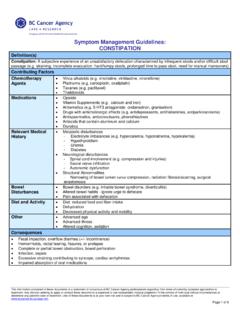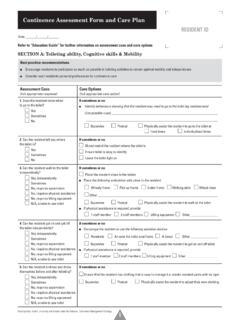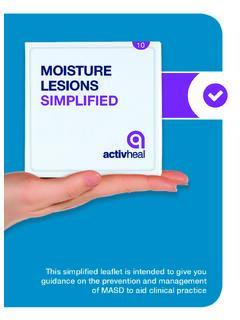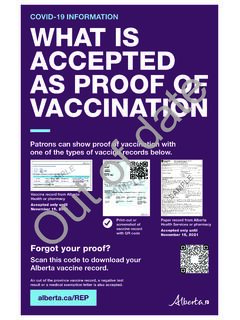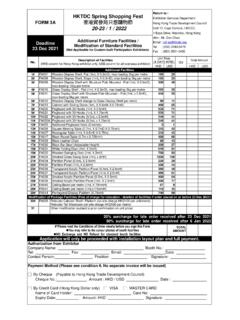Transcription of Symptom Management Guidelines: DIARRHEA
1 Symptom Management Guidelines: CANCER RELATED DIARRHEA Definition Cancer Related DIARRHEA (CRD): An abnormal increase in stool frequency, volume, and liquidity that is different from the usual patterns of bowel elimination; results from cancer or related treatment(s) Contributing Factors Cancer Related Neuroendocrine tumors ( VIPomas, carcinoid, gastrinomas) Lymphoma Graft vs. host disease after bone marrow transplant Cancer Treatment Related Capecitabine 5 fluorouracil Irinotecan Leucovorin Most small molecule oral tyrosine kinase inhibitors Immunotherapy Checkpoint inhibitors ( Ipilimumab) Biotherapy ( high dose Interferon or Interleukin 2) Radiation Therapy Pelvis, abdomen, lumbar, para-aortic fields Surgical History Celiac plexus block Large or small bowel resection Cholecystectomy Pancreaticoduodenectomy (whipple procedure)
2 Vagotomy Terminal ileal resection and loss of ileocecal valve Medications Laxatives ( stool softeners, stimulant bulk laxatives) Antibiotics ( cephaliexin, amoxicillin, clindamycin, clavulanic acid-amoxicillin) Prokinetic agents ( metoclopramide) Narcotic withdrawal Antihypertensives Non- steroidal anti inflammatory agents (NSAIDs) Potassium supplements Magnesium-containing antacids Liquid medications containing sorbitol ( acetaminophen elixir) Hypertonic liquid medications Other ( misoprostol) Relevant Medical History Partial bowel obstruction, fecal impaction with overflow Obstruction of common bile duct Inflammatory bowel disease ( Crohn s disease, ulcerative colitis) Irritable bowel syndrome, diverticulitis, iIschemic colitis Diabetes Hyperthyroidism Hypoalbuminemia Conditions that may require use of warfarin ( venous thrombosis, cardiac surgeries) Other Advanced age Anxiety, stress Recent travel Infection- viral ( norovirus), bacterial ( , )
3 , parasitic, sexually transmitted Post-pyloric hyperosmolar feedings and/or high feeding rate Lactose intolerance Herbal supplements ( milk thistle, aloe, cayenne, saw palmetto, ginseng) The information contained in these documents is a statement of consensus of BC Cancer Agency professionals regarding their views of currently accepted approaches to treatment. Any clinician seeking to apply or consult these documents is expected to use independent medical judgement in the context of individual clinical circumstances to determine any patient's care or treatment. Use of these documents is at your own risk and is subject to BC Cancer Agency's terms of use, available at Page 1 of 6 Consequences Risk for severe dehydration and electrolyte imbalances, cardiovascular compromise Risk for infection, sepsis Chemotherapy dose delays, reductions, discontinuation of treatment Quality of life distress, compromised role function, decreased functional status, exacerbation of other symptoms DIARRHEA may result in increased INR.
4 Or increased risk of bleeding for patients on warfarin Focused Health Assessment GENERAL ASSESSMENT Symptom ASSESSMENT PHYSICAL ASSESSMENT Contact and General Information Physician name - oncologist, family physician Pharmacy Home health care Other healthcare providers Allergies Consider Contributing Factors Cancer diagnosis and treatment(s) note type and date of last treatment Medical history Medication profile ( warfarin, antibiotics) Recent lab or diagnostic reports (if patient is on warfarin consider increasing frequency of INR monitoring) Normal What are your normal bowel habits? Do you have an ostomy? If so, how many times do you normally empty/change the bag?
5 Are you aware of any medications that you are taking that could cause DIARRHEA ( antibiotics, warfarin) Onset When did DIARRHEA begin? How many bowel movements in the last 24 hours? If ostomy, how many times did you empty/change bag? Provoking / Palliating What brings on the DIARRHEA ? Anything that makes the DIARRHEA better? Worse? Quality Describe your last bowel movement Was there any blood or mucous? Was it loose or watery? Can you estimate the amount, large or small volume? Can you describe the odour? Region / Radiation- N/A Severity / Other Symptoms How bothered are you by this Symptom ? (on a scale of 0 10, with 0 being not at all to 10 being the worst) Have you been experiencing any: - Abdominal cramping - DIARRHEA overnight (nocturnal stools) - Incontinence of stool - Fever - possible infection - Dry mouth, thirst, dizziness, weakness, dark urine -possible dehydration - Severe abdominal pain, bloating, nausea, vomiting - possible bowel obstruction - Skin breakdown around your rectum/colostomy Are you able to keep fluids down?
6 What are you drinking? How much? What is your dietary intake? Are you urinating normally? Treatment What medications or treatments have you tried? Has this been effective? Vital Signs As clinically indicated *HR and BP-supine and sitting, temperature Weight Take current weight and compare to pre treatment or last recorded weight Hydration Status Assess skin turgor, capillary refill, mucous membranes Amount and character of urine Abdominal Assessment Auscultate abdomen - assess presence and quality of bowel sounds Assess for abdominal pain, tenderness, distention stool Examination Inspect stool for colour (visible blood or mucous)
7 , consistency, volume, and odour Skin Integrity Assess perineal or peristomal skin integrity Note any areas of erythema, edema, exudates, bleeding or skin breakdown Mental Status Assess for confusion, alterations in level of consciousness The information contained in these documents is a statement of consensus of BC Cancer Agency professionals regarding their views of currently accepted approaches to treatment. Any clinician seeking to apply or consult these documents is expected to use independent medical judgement in the context of individual clinical circumstances to determine any patient's care or treatment. Use of these documents is at your own risk and is subject to BC Cancer Agency's terms of use, available at Page 2 of 6 Understanding / Impact on You Is your DIARRHEA interfering with your normal daily activity (ADLs)?
8 Value - What do you believe is causing your DIARRHEA ? DIARRHEA GRADING SCALE* NCI Common Terminology Criteria for Adverse Events (Version ) GRADE 1 (Mild) GRADE 2 (Moderate) GRADE 3 (Severe) GRADE 4 (Life - threatening) GRADE 5 Increase of <4 stools per day over baseline; mild increase in ostomy output compared to baseline Increase of 4 - 6 stools per day over baseline; moderate increase in ostomy output compared to baseline Increase of >=7 stools per day over baseline; Incontinence; hospitalization indicated;severe increase in ostomy output compared to baseline; limiting self-care ADL ( bathing, dressing, feeding self, using the toilet, taking medications) Life-threatening consequences.
9 Urgent intervention indicated Death *A semi-colon indicates or within the description of the grade and a single dash (-) indicates a grade is not available *Step-Up Approach to Symptom Management : Interventions Should Be Based On Current Grade Level and Include Lower Level Grade Interventions As Appropriate GRADE 1 (First 24 hours of onset) NON URGENT: Prevention, support, teaching, & follow-up as clinically indicated Patient Care and Assessment Collaborate with physician to rule out other causes or concomitant causes of DIARRHEA and to determine if further investigation warranted Dietary Management Encourage: - 10-12 cups of fluids throughout the day - Low fat, low fiber diet ( white rice and bread, applesauce) - Soluble fiber to help build stool consistency ( fruits and vegetables without skins, oat bran, barley) - Small, frequent meals Avoid.
10 - Spicy, fried foods - Insoluble fib er ( skins of fruits and vegetables, wholegrain and multigrain foods) - Very hot or cold foods/fluids - Sorbitol-containing substances ( sugar-free gums and candy) - Alcohol, caffeine Pharmacological Management Avoid/discontinue any medications that may cause or exacerbate DIARRHEA ( bulk laxatives, metoclopramide) in collaboration with physician and pharmacist If patient is taking warfarin, in collaboration with physician: The information contained in these documents is a statement of consensus of BC Cancer Agency professionals regarding their views of currently accepted approaches to treatment. Any clinician seeking to apply or consult these documents is expected to use independent medical judgement in the context of individual clinical circumstances to determine any patient's care or treatment.












